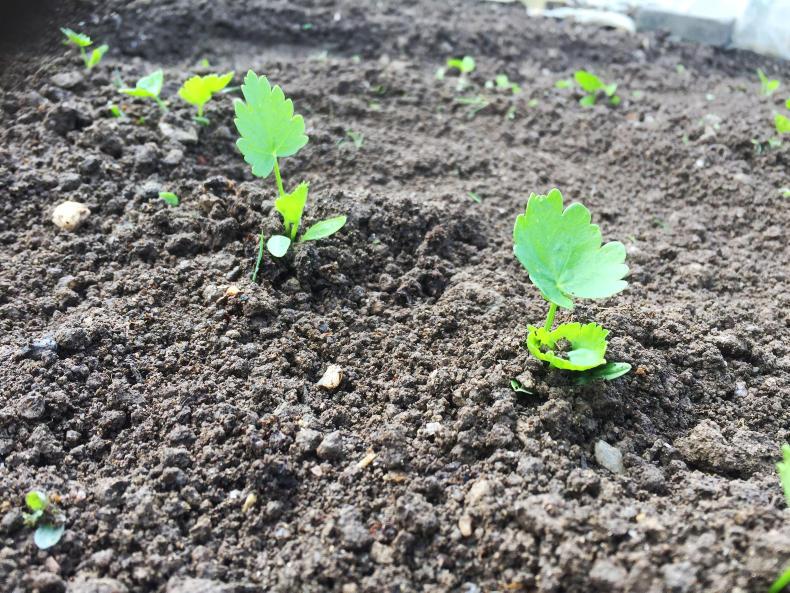This week I have been sowing my parsnips outside in the veg patch. Unlike carrots, they are relatively easy to grow (once you have persuaded them to germinate), and since they store well in the soil over the winter they are a valuable winter storage crop. I grow around 40 parsnips, which is more than enough to keep us happy between November, when we start hankering for root crops and the following March. To do this I need to allocate around 2m of growing space (in a standard bed you will get three rows of parsnips).
Most parsnip seed packets will tell you to sow them in February – don’t do it
Though I practice mainly a no-dig type of growing, I always put a bit of work in to the root crop bed where carrots and parsnips will be sown – I start by turning over the soil with a fork (to a depth of a foot) which I think is the key to a decent crop since the roots can descend into the soil happily, with no obstructions such as hard soil or stones to thwart their growth. I then rake the soil well to even it off before sowing and break up large clods of soil.
Most parsnip seed packets will tell you to sow them in February – don’t do it. Far better to leave it until around now when germination will be more reliable thanks to warmer weather. To sow, make a drill 2cm deep – if soil is dry, dampen. Sow one seed every 5cm in rows 30cm apart and cover in with soil. Germination takes up to three weeks. When seedlings appear, thin to 10cm apart for medium-sized parsnips. Once you have sown them, there is very little maintenance needed. Weed carefully until well established and watering shouldn’t be necessary except in dry spells. Parsnips are ready to rock when the foliage starts to die away in autumn, but flavour improves after first frosts. Lift them out of the soil carefully with a fork. Leave in soil until ready to eat, but lift by March.
Watch a short GIY video tutorial on parsnips here.
As your potato plants grow, you need to “earth them up” – this is a process of drawing soil up around the plant’s stems to cover them. It has a number of benefits. First of all it increases the length of the underground “potato-bearing” stem so that you end up with more spuds per plant. It also stops potatoes from poking through the soil, which would cause them to go green. And finally it is also thought to help prevent blight from travelling from the leaves of the plant in to the tubers. Earthing up is repeated every three weeks or so.
Start by loosening the soil between the rows of plants using a fork – this will clear the soil of any weeds and make it easier to work with. Then using a rake or a ridging hoe, draw the soil up around the potato plants covering about half of the stem (10cm).
If you are growing your potatoes in containers or sacks, simply add more compost (about 5cm) at regular intervals until the container is almost full.
Read more
GIY: Getting bang from your buck in the veg patch
GIY with Michael Kelly: red hot chilli peppers
This week I have been sowing my parsnips outside in the veg patch. Unlike carrots, they are relatively easy to grow (once you have persuaded them to germinate), and since they store well in the soil over the winter they are a valuable winter storage crop. I grow around 40 parsnips, which is more than enough to keep us happy between November, when we start hankering for root crops and the following March. To do this I need to allocate around 2m of growing space (in a standard bed you will get three rows of parsnips).
Most parsnip seed packets will tell you to sow them in February – don’t do it
Though I practice mainly a no-dig type of growing, I always put a bit of work in to the root crop bed where carrots and parsnips will be sown – I start by turning over the soil with a fork (to a depth of a foot) which I think is the key to a decent crop since the roots can descend into the soil happily, with no obstructions such as hard soil or stones to thwart their growth. I then rake the soil well to even it off before sowing and break up large clods of soil.
Most parsnip seed packets will tell you to sow them in February – don’t do it. Far better to leave it until around now when germination will be more reliable thanks to warmer weather. To sow, make a drill 2cm deep – if soil is dry, dampen. Sow one seed every 5cm in rows 30cm apart and cover in with soil. Germination takes up to three weeks. When seedlings appear, thin to 10cm apart for medium-sized parsnips. Once you have sown them, there is very little maintenance needed. Weed carefully until well established and watering shouldn’t be necessary except in dry spells. Parsnips are ready to rock when the foliage starts to die away in autumn, but flavour improves after first frosts. Lift them out of the soil carefully with a fork. Leave in soil until ready to eat, but lift by March.
Watch a short GIY video tutorial on parsnips here.
As your potato plants grow, you need to “earth them up” – this is a process of drawing soil up around the plant’s stems to cover them. It has a number of benefits. First of all it increases the length of the underground “potato-bearing” stem so that you end up with more spuds per plant. It also stops potatoes from poking through the soil, which would cause them to go green. And finally it is also thought to help prevent blight from travelling from the leaves of the plant in to the tubers. Earthing up is repeated every three weeks or so.
Start by loosening the soil between the rows of plants using a fork – this will clear the soil of any weeds and make it easier to work with. Then using a rake or a ridging hoe, draw the soil up around the potato plants covering about half of the stem (10cm).
If you are growing your potatoes in containers or sacks, simply add more compost (about 5cm) at regular intervals until the container is almost full.
Read more
GIY: Getting bang from your buck in the veg patch
GIY with Michael Kelly: red hot chilli peppers









SHARING OPTIONS